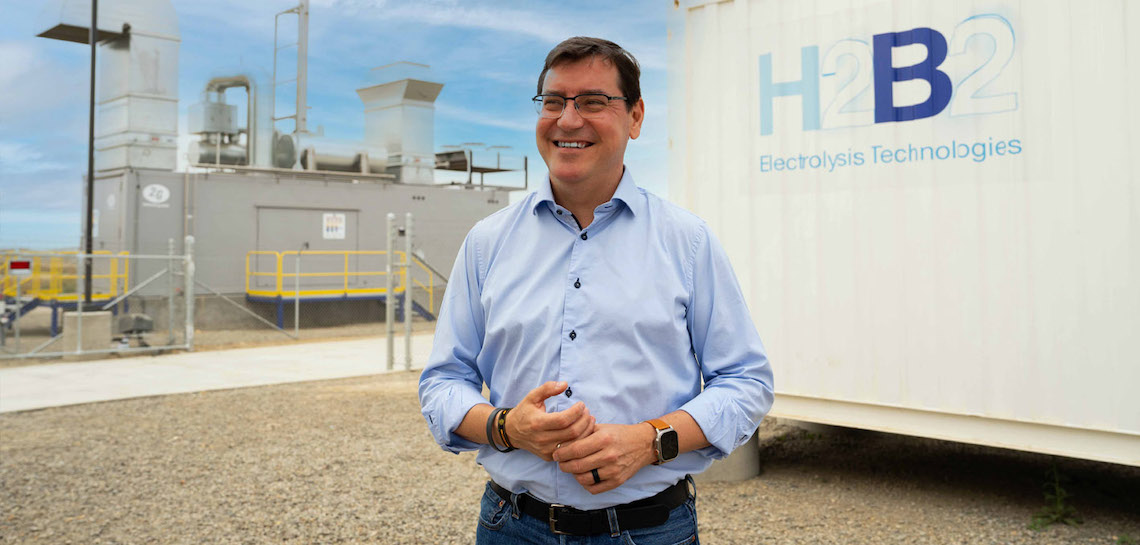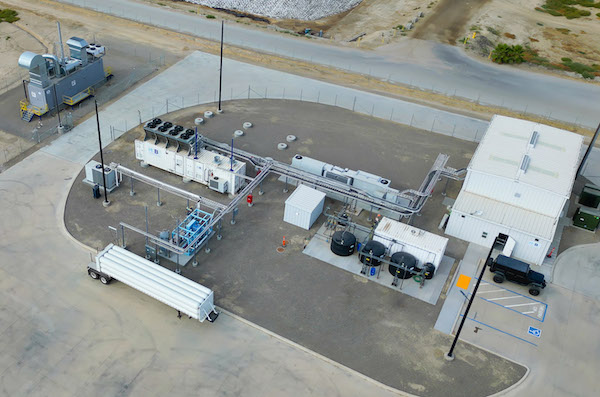
Pedro Pajares, CEO of H2B2 USA, at SoHyCal in Fresno County. H2B2 USA photo
Written by Frank Lopez
H2B2 Electrolysis Technologies, a Spain-based provider of green hydrogen energy solutions, in Fresno County this month unveiled SoHyCal — the largest hydrogen production plant powered entirely by renewable energy in North America to date.
The Fresno County Economic Development Corp. partnered with H2B2 to make the SoHyCal project possible. The plant sits on a 324-acre lot near Whitesbridge Avenue and James Road, about 7 miles east of Mendota.
The plant began its first phase of hydrogen production in June, with an initial capacity of 1.2 tons of hydrogen daily.
Once phase 2 of the project is completed over the next 13 months, SoHyCal is expected to be one the largest green hydrogen production facilities in the U.S. It will be able to produce up to 3 tons per day.

At full capacity, the plant could produce enough hydrogen for 210,000 cars or 30,000 city buses per year.
Currently, the plant is powered by a biogas engine that burns biogas from an organic waste source near the facility. By phase 2, expected to be completed by 2025, the plant will be powered by photovoltaic solar energy.
H2B2 USA CEO Pedro Pajares has been working in the energy industry for decades, starting out in the solar industry and then transitioning to hydrogen, drawn to the challenge of something new.
He said hydrogen is key if the state wants to meet its environmental goals by 2045.
Pajares said he knew California would be the best state to build a hydrogen plant because of its fabric of supporting and pioneering companies.
The Central Valley provided H2B2 USA with affordable land and options to produce its own energy.
H2B2 USA secured nearly $4 million in grant funding from the California Energy Commission for the SoHyCal project in 2019, committing to help support the regional economy.
Currently there are four employees working at the facility, which is remotely controlled. Operations do not require many people onsite, Pajares said.
Hydrogen has been produced in the U.S. since for many decades now, but the focus is now shifting to producing clean, green hydrogen.
Conventional grey hydrogen is made from natural gas, or methane, which results in emissions.
H2B2’s hydrogen is created through a process called electrolysis, using an electrical current to break down water molecules into oxygen and hydrogen.
There is an eight color spectrum of hydrogen denoting how it is produced. That includes pink hydrogen, which is made using nuclear energy, and blue hydrogen, which is made using fossil fuels.
Pajares compares costs for hydrogen to that of solar energy in that when it first started hitting the market around 25 years ago, it was very expensive. But the prices are now a fraction of what they used to be.
He believes the same trend will take hold for green hydrogen.
According to the Department of Energy, it costs approximately $78 to $90 to fill the tank of a hydrogen car, depending on the car and local incentives.
Pajares said that in a few years, those prices will become comparable to gas-fueled cars, if not cheaper.
“Hydrogen cars will become more common, especially with incentives from California to buy them,” Pajares said.
Locally, hydrogen has the opportunity to be used in the ag industry, manufacturing, public transportation systems and to manufacture chemicals.
An added benefit of hydrogen production, Pajares said, is that plants use 90% less water than farms. The process also doesn’t require potable water.
Pajares wants the community to know that SoHyCal is not only a California company, but a Fresno company. And they hope to be able to educate consumers on what hydrogen means for their community.








